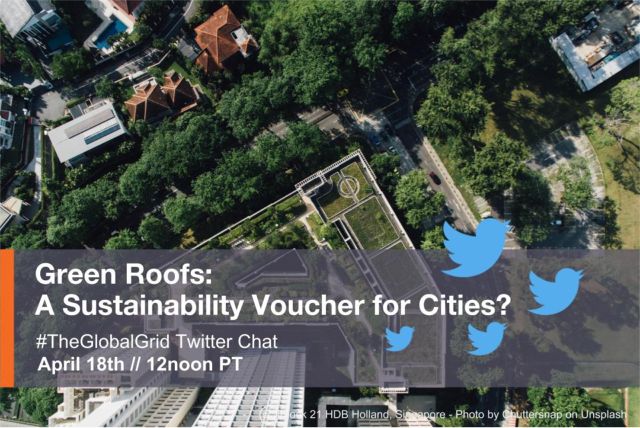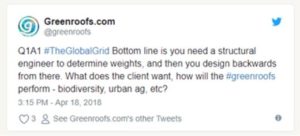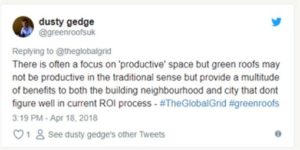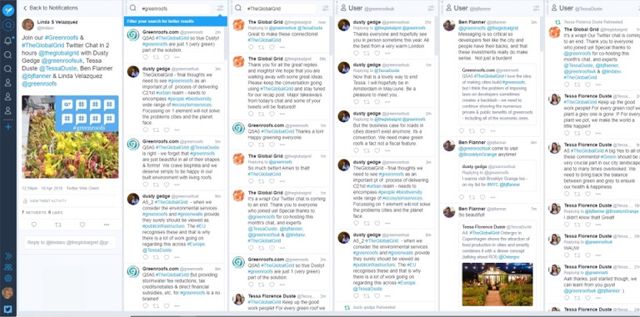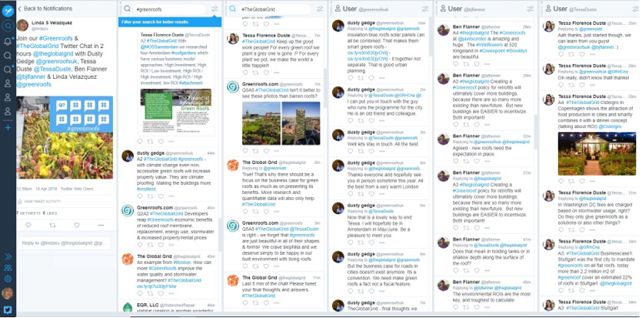Green Roofs: A Sustainability Voucher for Cities?
On April 18 I participated in our first Twitter Chat with The Global Grid. Along with our fellow panelists Dusty Gedge, Tesse Duste, and Ben Flanner, Sarah Essbai of The Global Grid hosted the live event and I have to say it was pretty cool!
I’ll take this opportunity to thank Sarah of The Global Grid for reaching out to us, as they say.
Green Roofs #TheGlobalGrid Chat Recap
To get an idea of what you missed, check out Sarah’s post Green Roofs: A Sustainability Voucher for Cities? #TheGlobalGrid Chat Recap. Here’s an excerpt:
April’s #TheGlobalGrid Twitter chat was dedicated to green roofs, a special sustainable building feature gaining popularity in cities around the world. During our chat, we asked if green roofs benefit more than the buildings they sit atop and if their many benefits extend to the city level; contributing to citywide sustainability goals.
We are pleased to have been joined by Greenroofs.com to co-host this special World Landscape Architecture Month chat, and by four green roofs experts in Europe and the United States who constituted the chat panel:
- Tessa Duste, co-founder of Moss Amsterdam,
- Ben Flanner, Director of Agriculture, President, and co-founder of Brooklyn Grange Rooftop Farm in New York City,
- Dusty Gedge, co-founder of Livingroofs.org and the current President of the European Federation of Green Roof Associations (EFB) in London,
- Linda Velazquez, ASLA, LEED, AP, GRP, publisher, and editor of Greenroofs.com.
The conversation was structured around five questions. Our panelists’ answers were perceptive and insightful. Check a summary of their contributions below:
- Green roof design and type depend greatly on the structure of their host building
Green roofs present an extra load that should be accounted for in the structural calculations of new buildings or tolerated by the structures of existing buildings. While growing food might be one of the most popular features of green roofs, most existing buildings structures are not apt to carry the extra weight of intensive green roofs. Retrofitting projects can, therefore, be often limited to installing extensive green roofs which still have great environmental benefits.
- Green roof costs are offset by their long-term benefits at the building and community scale
Green roofs are long-term investments. At the building level, they extend the roof’s life, reduce its energy costs and increase the property’s overall value. The benefits for the community are even greater. Green roofs contribute to making communities more sustainable and climate resilient. Accessible green roofs create additional open spaces for community activities and increase a neighborhood’s brand value, which attracts more development and investment creating a virtuous cycle of benefits.
Read more at The Global Grid here.
Virtually Fast & Furious
It was also my first time utilizing the TweetDeck app, and I ended up opening 5 more columns to follow everyone – of course, Aramis helped me and enjoyed the experience, too. Here are a couple of screen shots:
You know we are no strangers to Virtual Events, and think this is another great way to communicate the world over – Connecting the Planet + Living Architecture – at no or relatively no expense.
If you couldn’t join us, please do in our next Twitter Chat venture. And, if fast and furious along with greenroofs and walls excite you, join us in a Twitter Chat soon!
I’m not sure when that will be, but we’ll let you know and welcome your ideas for future topics and collaborations!
By Linda S. Velazquez, ASLA, LEED AP, GRP
Greenroofs.com Publisher & Greenroofs & Walls of the World™ Virtual Summits Host
 Greenroofs.comConnecting the Planet + Living Architecture
Greenroofs.comConnecting the Planet + Living Architecture
